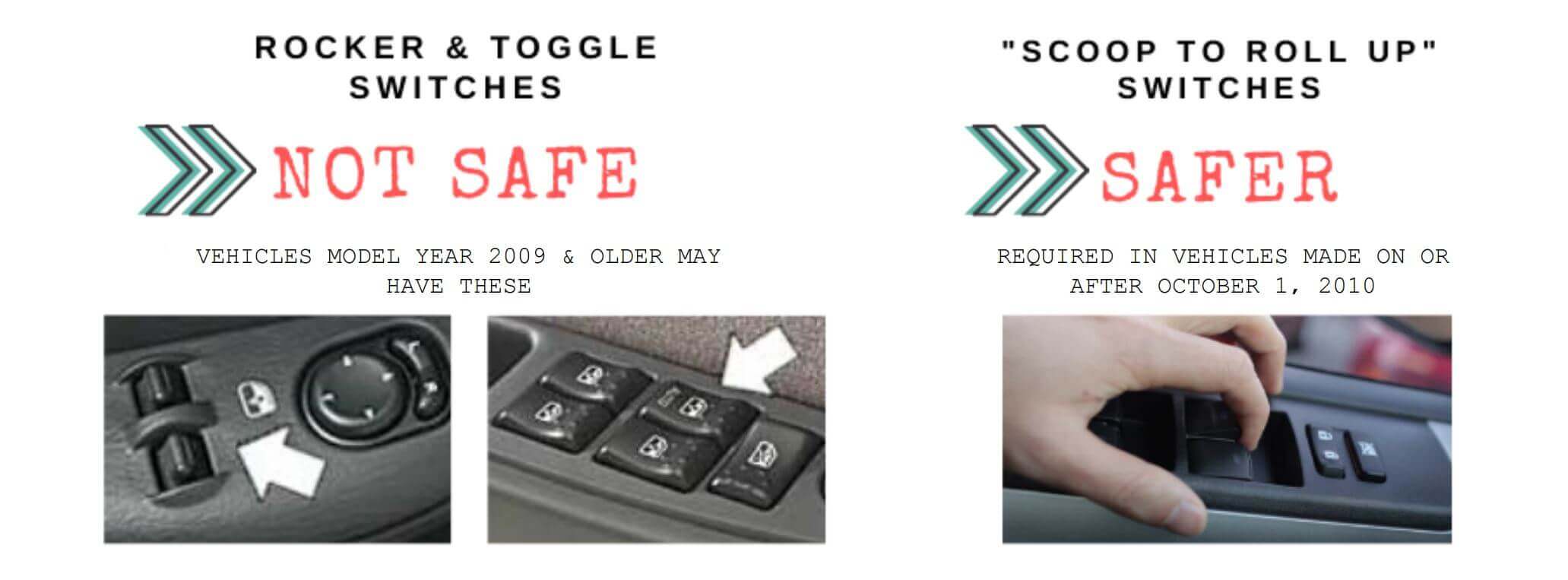Power Window Facts
Power windows in automobiles have killed or injured thousands of children, adults and pets.
Quick Facts
- Over 30 million U.S. adults have been personally injured or know someone who has been personally injured by someone else closing a car window according to a Harris Interactive poll in October 2009.
- Kids and Car Safety has documented nearly 100 children who have been strangled to death by power windows.
- It takes just 22 pounds of force to suffocate or injure a young child while power windows can exert an upward force of 30-80 pounds.
In response to these concerns, the Kids and Car Safety (KACS) organization has been working effectively to make power windows are safer for everyone, including our pets. KACS is responsible the passage of a law that mandated a regulation that was written by the National Highway Traffic Safety Administration (NHTSA). This new rule required all new vehicles manufactured on or after October 1, 2010 to have the safer ‘pull up to close/push down to open’ switches. (read the regulation). Under the new requirements, power window switches were required to be a switch that must be pulled up to close or pushed down to open and be flush with the surface where it is installed. This design greatly reduces the risk of accidental activation, as children and pets are less likely to push or pull the switch by accident.
In the past, some power window switches were designed to operate with a "toggle or rocker" switch, which meant that pushing the switch down would cause the window to close, and pushing it up would cause it to open. This design posed a serious risk to children, who could inadvertently activate the switch and become trapped in the window.
The number of children strangled by power windows has drastically decreased thanks to safer switches. However, injuries and deaths can still happen if the driver inadvertently rolls the window up on another passenger.
Power Window PSA Videos
Auto Reverse Technology
In 2009, NHTSA studied whether or not to require automatic reversing systems (ARS) technology, which stops a window if an obstruction is detected. This is much like the proven technology in garage doors and elevators and helps to prevent children and others from being injured or killed. Based on their research, NHTSA has incorrectly decided ARS is not necessary. NHTSA’s 2009 Notice of Proposed Rule Making (NPRM) declares ARS is not necessary based on extremely flawed data, which Kids and Car Safety can now prove to be grossly underestimated.
ARS technology would cost approximately $5-6 per car window. With the economies of scale, the cost would be reduced even further.
It is important to understand that just because you have an ARS in the driver and/or passenger side of the vehicle, that doesn’t mean the back seat windows have that same technology. In fact, many cars only have ARS in the front seat even though vulnerable children ride in the back seat.
Test your windows for auto-reverse safely:
Take a roll of paper towels or a rolled-up towel and place it between the window and door frame. Roll the window up taking caution not to get fingers close to the moving window. If the window continues to close on the towel, you do not have the auto-reverse safety feature on that window. If the window bounces back open, you do have the auto-reverse safety feature. (WARNING: Please exercise extreme caution doing this test and do not allow children to do this. Power windows have the ability to cut a finger off!)
Safety Tips
Power windows in vehicles can be a potential hazard for children, pets and any occupant in a vehicle. It is important to take steps to protect them from injury or even death. Here are some measures that can be taken to ensure children's safety around power windows:
- Use power window child safety locks: Most vehicles have a power window child safety lock feature that prevents children from opening or closing the windows.
- Parents and caregivers can teach children about the dangers of playing with power windows and the importance of keeping their hands and fingers away from the window controls.
- Ensure all passengers have hands, fingers and other body parts away from windows before rolling them up.
- Be aware that other power accessories like sun and moon roofs or electric seats can also pose a risk to young children. Children should NEVER be unsupervised in or around a vehicle.
Studies
Below are studies specific to vehicle power window injuries and deaths. This information is very helpful, but there is still much to be learned.
- Accidental strangulation in children by the automatic closing of a car window – February, 2018
- Unintentional non-traffic injury and fatal events: Threats to children in and around vehicles - 9/27/2017
- Safeguarding of pinch and shear points on power windows by limitation of the closing velocity: A pilot study – 2005
- A Study About Power Windows in Automobiles, Harris Interactive – July 17-20, 2003
- NHTSA Research Note: Injuries Associated With Hazards Involving Motor Vehicle Power Windows – May, 1997
- Injuries Associated with Specific Motor Vehicle Hazards: Radiators, Batteries, Power Windows, and Power Roofs – July, 1997
- Traumatic asphyxia in children – Feb, 1997
- Accidental strangulation by a motor vehicle window – 1997


